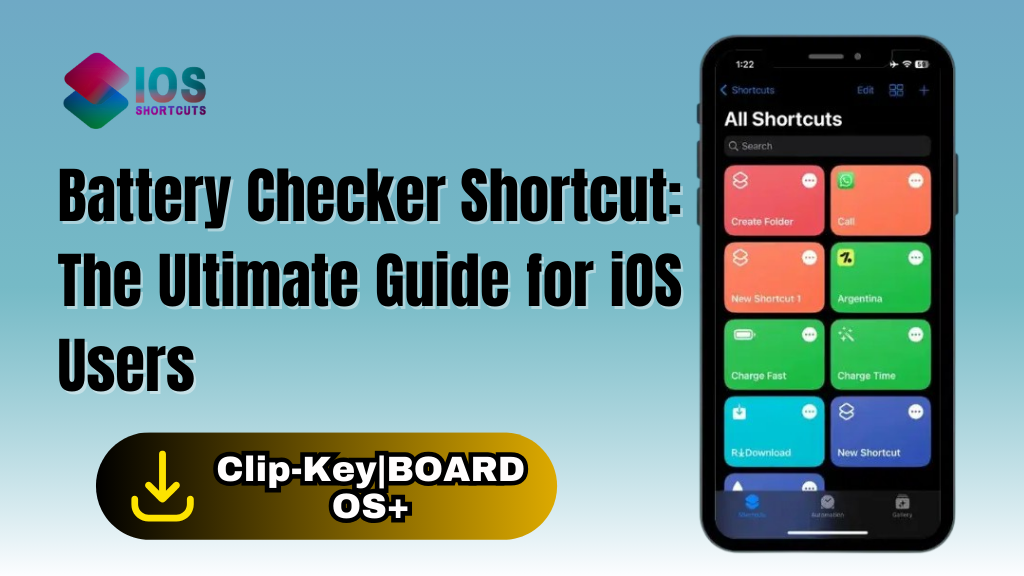
Battery Checker
Ever wondered how healthy your iPhone battery really is—beyond the basic “Maximum Capacity” shown in Settings? That’s where the Battery Checker Shortcut steps in. This powerful iOS Shortcut digs deep into your device analytics to give you detailed insights into your battery’s true condition, capacity, and wear. Whether you’re a casual iPhone user or a hardcore Apple geek, this guide will help you unlock its full potential.

What Is the Battery Checker Shortcut?
A Quick Overview
The Battery Checker Shortcut is a custom automation created for iOS Shortcuts that analyzes hidden system logs to extract detailed battery data. Think of it as a magnifying glass that reveals what Apple doesn’t show you upfront. From charging cycles to internal resistance, it provides data points that let you truly understand your battery’s state.
Who Should Use It?
This shortcut is ideal for:
- iPhone users wanting detailed battery diagnostics.
- Tech-savvy folks comparing battery wear across seasons.
- Apple Watch and iPad owners checking battery health consistency.
- Repair technicians or resellers assessing battery longevity.
If you’re using iOS 17 or iOS 18.4, the shortcut remains compatible—just be sure to update to ver5.3 or later.
Key Features of Battery Checker Shortcut (ver5.x)
Internal Resistance Measurement
New in version 5.x is the ability to track internal resistance, a crucial metric that impacts battery performance but isn’t usually visible. Internal resistance can spike with age or cold weather, making it a great early warning sign.
RichText and Manual Model Selection Options
Want cleaner, formatted results? Turn on RichText mode. Prefer to manually select your device model (especially for Apple Watch)? Enable ManualSelect. These options make the shortcut flexible and user-friendly.
Language and Update Check Settings
Don’t speak Japanese? No problem. Set English to True in the top dictionary to switch languages. You can also set UpdateCheck to True to receive notices for future versions automatically.
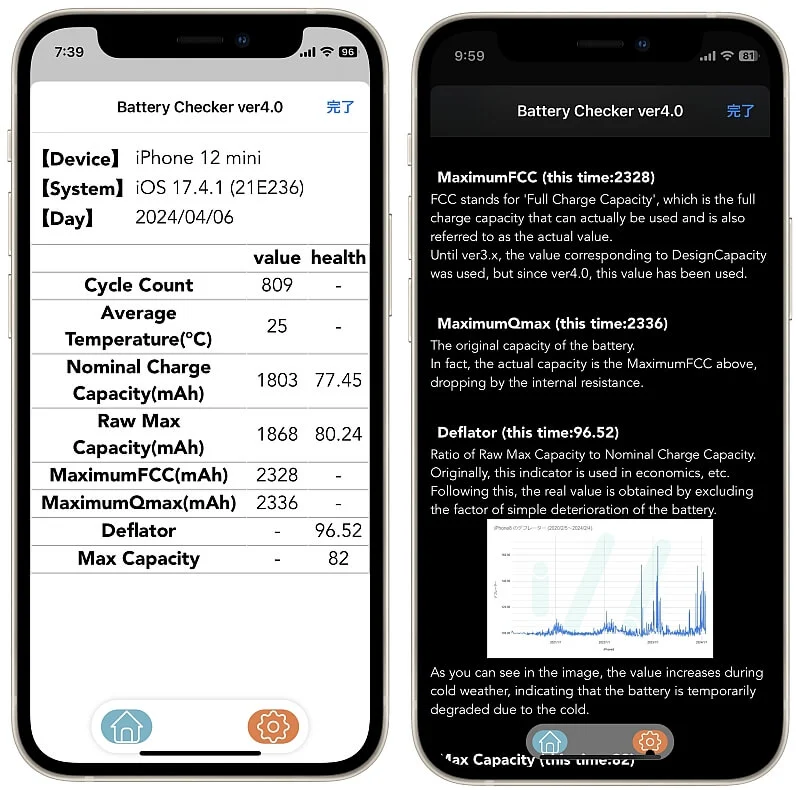
Understanding the Technical Terms
Design Capacity vs. Maximum FCC
Most users see “Battery Health” in Settings as a single percentage, but it’s a simplified metric. In reality, Design Capacity is the factory-set capacity, while Maximum Full Charge Capacity (FCC) is what your phone can currently hold.
Nominal vs. Raw Max Capacity
- Nominal Charge Capacity is the average expected max based on conditions.
- Raw Max Capacity is the actual, real-world data point from your phone’s analytics.
The shortcut calculates both to provide a balanced view.
Deflator and Seasonal Degradation
Ever noticed your battery life drops in the winter? That’s where the deflator value comes in. It’s calculated as Nominal * 100 / Raw. It tends to rise in colder months and settle in warmer ones—perfect for spotting seasonal trends.
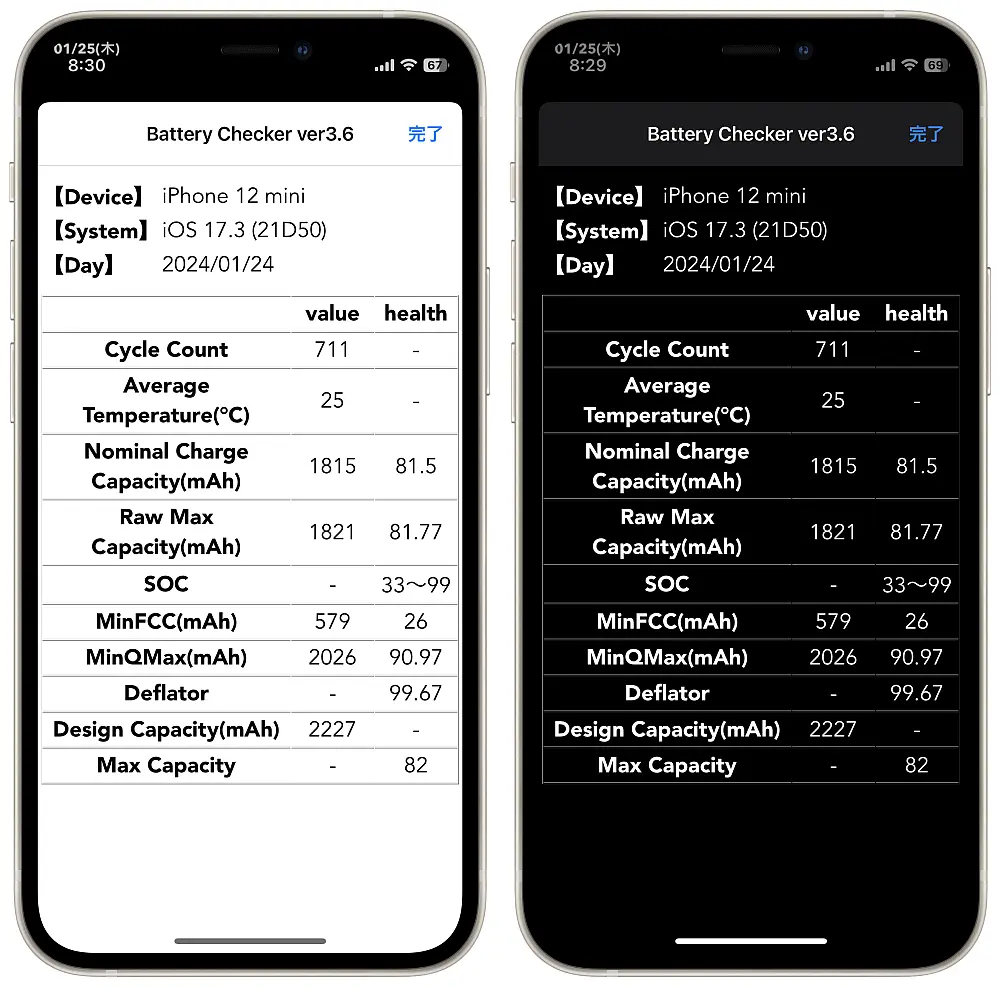
How to Set Up the Battery Checker Shortcut
Step-by-Step Installation Guide
- Download the Shortcut (official release).
- Enable “Allow Untrusted Shortcuts” in Settings > Shortcuts.
- Run the shortcut once and grant required permissions.
- Upload your
log-aggregated-xxxx-xx-xxfile from Settings > Privacy > Analytics.
⚠️ Be sure to use version 5.3 or higher on iOS 18.4.
Manual Edits: Setting Design Capacity
Since Apple hides some values, you may need to manually input your device’s design capacity:
- Open the shortcut’s editing mode.
- Find the top-level Dictionary action.
- Locate
design_capacity.
How to Use the Shortcut on iOS 17 and iOS 18.4
Navigating Log Files and Analytics
You’ll need to grab analytics logs manually:
- Go to
Settings > Privacy > Analytics & Improvements > Analytics Data. - Look for
log-aggregated-YYYY-MM-DD. - Tap Share > Save to Files.
This file is parsed by the shortcut to reveal battery data.
Exporting and Sharing Data
Once analyzed, you can choose to export the results in:
- Plain text
- RichText format
- Copy to clipboard
- Share via AirDrop or Notes
Version History and Updates
Changes from ver2.x to ver5.x
ver2.x – Simple Mode and Model Selection
This version introduced model-based health estimates and a simplified interface. Ideal for users with only one Apple device.
ver3.x – Deflator and Layout Changes
Here, the “deflator” metric made its debut—highlighting seasonal battery changes. It also introduced internal capacity comparisons.
ver4.x – Health Calculation Shift
Battery health began using MaximumFCC instead of Design Capacity, leading to more accurate health percentages.
ver5.x – Processing and Display Enhancements
- Added internal resistance readings.
- Improved UI and RichText formatting.
- Better version checks and layout flow.
Troubleshooting Common Issues
Timeouts and Execution Errors
Running into the dreaded “This shortcut took too long” message? Here’s what you can do:
- Reduce the log file size (delete older parts manually).
- Add a “Stop Shortcut” action at the end.
- Check your internet—some steps require lightweight web checks.
Formula and Match Failures
Occasionally, the shortcut can’t match text due to Apple changing log formats. If this happens:
- Update to the latest version.
- Reconfigure your dictionary settings.
- Re-download logs from Analytics.
Tips for Accurate Battery Health Monitoring
Understanding Fluctuations
Battery health isn’t static. It changes with temperature, usage, and charge habits. Don’t panic if it dips a few percent—it’s normal.
Using External Resources for Capacity Data
Get accurate Design Capacity numbers using online databases to ensure your health percentages are valid. Always double-check with at least two sources.
Conclusion
The Battery Checker Shortcut turns your iPhone into a battery health lab. With it, you’re no longer in the dark about your device’s power performance. Whether you’re trying to squeeze more life out of an old iPhone or just keeping tabs on seasonal changes, this shortcut gives you the tools to stay informed.
And remember—battery health isn’t just about numbers. It’s about understanding trends, adapting to them, and making smarter choices. Keep your shortcut updated, stay warm in the winter, and your phone will thank you for it.
You can also use: iPhone Battery Health Check Shortcut – [Check Real iPhone or iPad Battery] Updated 2025
Frequently Asked Questions
1. Is the Battery Checker Shortcut safe to use?
Yes! It only reads your analytics logs and doesn’t send data anywhere. All processing is done locally on your device.
2. Can I use this with my iPad or Apple Watch?
Absolutely. Just make sure to enable ManualSelect and input the correct design capacity for your device.
3. What if the shortcut times out?
Try trimming the log file before importing, or add a Stop Shortcut action to avoid timeouts.
4. Do I need to update the shortcut regularly?
It’s recommended. New iOS versions may change how logs are recorded, and updates keep compatibility smooth.
5. What does a deflator value above 100 mean?
It usually indicates seasonal performance loss, especially during colder months. It’s not a sign of permanent damage.

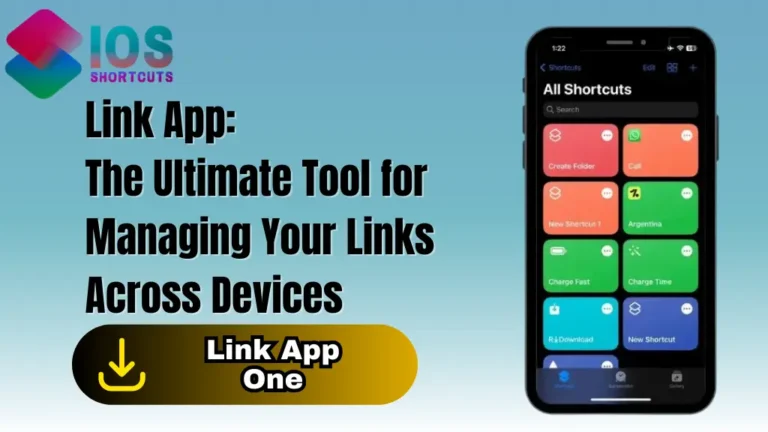
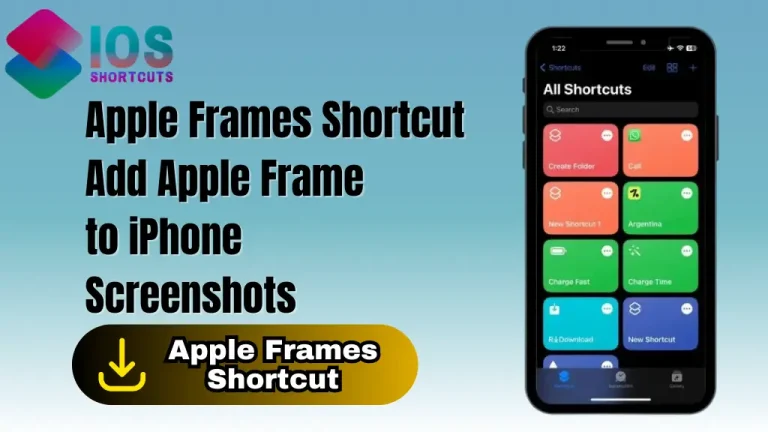

![iPhone Battery Health Check Shortcut - [Check Real iPhone or iPad Battery] Updated 2025 8 iPhone Battery Health Check Shortcut – [Check Cycle Counts]](https://shortcutsforios.com/wp-content/uploads/2023/06/iPhone-Battery-Health-Check-Shortcut-–-Check-Cycle-Counts-768x432.webp)